| Oh, The Weather Outside Is ... Warm | ||||
The following article is courtesy of Traditions Media.
That makes this ailment tougher. Gloom? Despair? But late formation begs a question: Is the first-ice bite so grand because of the sudden change in environment, no matter when the water hardens? I probed the minds of two preeminent ice anglers. Where you catch fish at first-ice will depend on when, exactly, it forms. “There’s still the prospect of finding fish in your best first-ice spots of the past, if the weeds are still standing and green,” said Minnesota fishing guide Brian “Bro” Brosdahl.
“Underwater plants do more than give bugs and minnows a place to hide from predators,” he said. If Bro spots still-standing vegetation through his hole, he’ll drill more holes as close to the edge of the bed of foliage as possible. Spoons that tumble on the drop -- like Custom Jigs & Spins’ Slender Spoons and Keweenaw Tackle’s Fin-Wing, in the photo below -- are easy for fish to zone-in on. |
||||
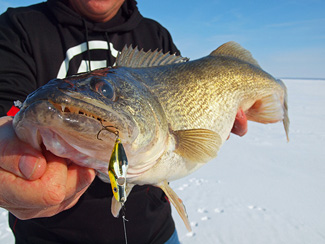 |
||||
The lures impart a blaze of reflection, and a fish’s lateral line easily picks up the vibration. If panfish are your quarry, smaller offerings, like the 1/16-ounce Slender Spoon, 1/4-ounce Fin-Wing and Bro’s Northland Buck-Shot Flutter Spoon are prime selections. Simply go up the totem-pole to larger sizes of the same baits for predators like walleyes and pike. No matter what size your targeted species, employ a lift of the rod tip with a quick drop, so the spoon rips up through the water column, and then free-falls toward the floor. If your shallow spots dried up by the time safe ice formed, head toward the lake’s main basin. Enter Custom Jigs and Spins’ pro-staffer Russ Maddin. This iceaholic is a hole hopper if there ever was one. Armed with nothing more than a Frabill sled, hand auger, couple of rods and a small handful of baits, Maddin hoofs it by foot through the deep, lake-effect-snow on the ice of northwest lower Michigan’s lakes. “Even though it may be first-ice, technically, the fish might already be migrating to deep water.” But they’re not all going to be there at the same time. Rather, they’re spread out on structure along the way. Maddin’s a fan of heavy jigs for hole hopping, making sure to fish every one, whether he sees fish on his sonar or not. Chekai and Majmun tungsten jigs tipped with spikes, waxies and/or Wedgee and Micro Noodle plastics are his go-tos for panfish. So does the Pro Finesse Drop Chain tipped with grubs. The fish can be really spread out when first-ice comes later in the season, he says. There’s lots of water to cover, so it’s often just one fish here, one there. But the next thing you know, you’ll have a bucketful of fish, if you keep moving around. So where will the fish be when the ice is finally thick enough? That will depend on when it finally forms. But don’t stay there, if the weeds died off. If that’s the case, head to the lake’s main basin. Just make sure to stop and fish along the way. Mitch Eeagan is a writer and photographer from Michigan’s Upper Peninsula. |




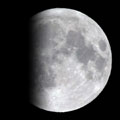
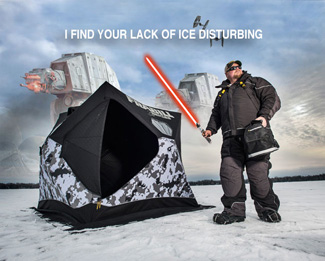 Seasonal depression.
Seasonal depression.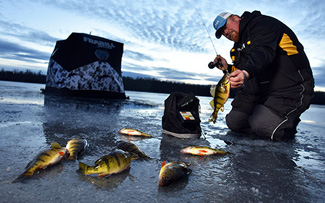 As soon as Bro bores a conservative swath of holes, he deploys his Humminbird
As soon as Bro bores a conservative swath of holes, he deploys his Humminbird 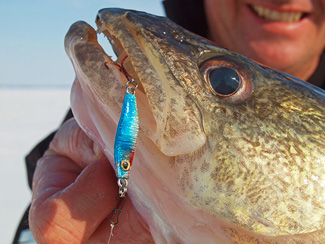 The larger, 1/4-ounce to 3/8-ounce
The larger, 1/4-ounce to 3/8-ounce 